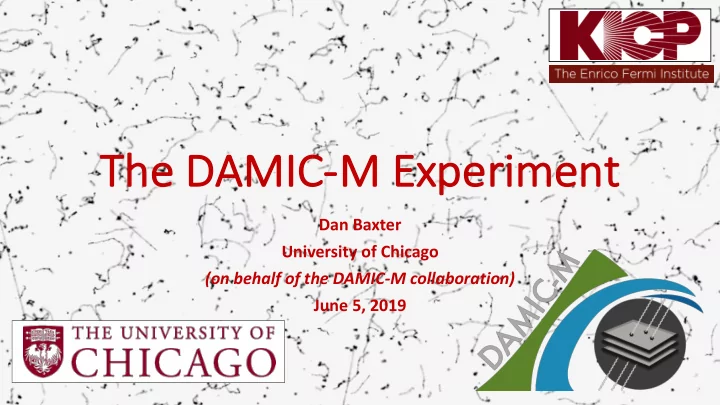

Th The DAMIC-M Ex M Experi riment Dan Baxter University of Chicago (on behalf of the DAMIC-M collaboration) June 5, 2019
J. Tiffenberg et al , Phys. Rev. Lett. 119 , 131802 (2017) [arXiv:1706.00028 ] Ch Charge-Coupled Device ces Sub-electron readout noise! à single charge resolution • Non-destructive ionization readout of sub- keV energy deposits in bulk silicon (675 microns thick) • Charges are drifted and collected in 15x15 micron pixels before being read out • Charges are moved from pixel-to-pixel until readout with low charge transfer inefficiency • DAMIC@SNOLAB has already demonstrated the capability of fully-depleted silicon CCDs to search for dark matter: o A. Aguilar-Arevalo et al , Phys. Rev. Lett. 118, 141803 (2017) [arXiv:1607.07410] • new Skipper CCDs (shown above) allow consecutive non-destructive readout of a single pixel à sub-electron readout noise 2
De Detect ctio ion T Tech chniq ique • DAMIC at Modane (DAMIC-M) • DAMIC-M will be Preliminary design constructed from 50 low background Skipper CCDs ( ~ 1 kg) • Sub-electron resolution allows for a 2-3e - threshold ( ~ 3 eV) • Continuous readout minimizes leakage current and deadtime • Target background rate of <0.1 dru 3
Diffusion Model for Different Fits Event Ev m) 14 µ Note: energy effects not shown ( xy Re Reconstruction s 12 10 8 • As charges diffuse across the 6 CCD, they drift apart preliminary… µ µ Gaussian Fit. A=2.16e+02 m 2 , b=8.86e-04 m -1 4 µ µ Distribution Median. A=2.30e+02 m 2 , b=8.57e-04 m -1 • The dispersion of collected µ µ Landau Fit. A=1.83e+02 m 2 , b=9.76e-04 m -1 2 µ µ Fixed A Value. A=2.20e+02 m 2 , b=8.80e-04 m -1 charges (σ) carries information 0 100 200 300 400 500 600 µ Depth ( m) about the depth of an event 4323 keV α 4 keV β 41 keV β • The distribution of ~ σ x energy over the pixel array tells ~ σ y the event type 4
DA DAMIC-M M Se Sensitivity Nuclear Recoil Sensitivity Hidden Photon Sensitivity 5
DA DAMIC-M M Se Sensitivity (DM-elec electr tron n scatter ering ing) F DM = 1 F DM ∝ 1/q 2 6
K. Ramanathan et al , Phys. Rev. D 96, 042002 (2017) [arXiv:1706.06053] Advantages Adv • Dark current : demonstrated in DAMIC@SNOLAB o < 10 −3 e − pix −1 day −1 at operating temperature of ∼ 140K • Background Rejection : isolation of certain radioisotopes by observation of multiple decay chain processes o Example of a likely 32 Si- 32 P coincidence with half life of 14.3 days (below) Energy Response: linear down • to very low energies (above) Linear within 5% down to 40 eV, o or 10 electrons 7 A. Aguilar-Arevalo et al , JINST 10 (2015) P08014 [arXiv:1506.02562]
Ch Challenges s - Ba Backg kground Mo Modeling • DAMIC@SNOLAB acts as an Rate (dru) exceptional test-bed for understanding and mitigating background sources • We are well underway in DAMIC at SNOLAB producing a complete background model for DAMIC@SNOLAB ( stay tuned… ) • Dominant backgrounds for DAMIC-M expected to come from o 32 Si (can be rejected through coincidence with 32 P) o Tritium from silicon activation (can be mitigated through shielding during transport/storage) 8
1. Switching to electroformed copper Future Futur e Prospec pects ts à eliminate 238 U, 232 Th, 210 Pb contributions • Design and CCD Manufacturing underway 2. Careful handling procedures • Background controls and modeling à reduced 210 Pb surface contributions progressing 3. Clean cabling • Construction at Modane begins 2020 à reduced 238 U, 232 Th, and 40 K contributions • Physics data in 2023 o Goal: 1 kg-year at 0.1 dru background 4. Shielding during transport/manufacturing • Funded by ERC and NSF (2018 – 2023) à Reduced 3 H, 22 Na, and Copper activation products … and more to achieve 0.1 dru http://damic.uchicago.edu/ 9
Recommend
More recommend